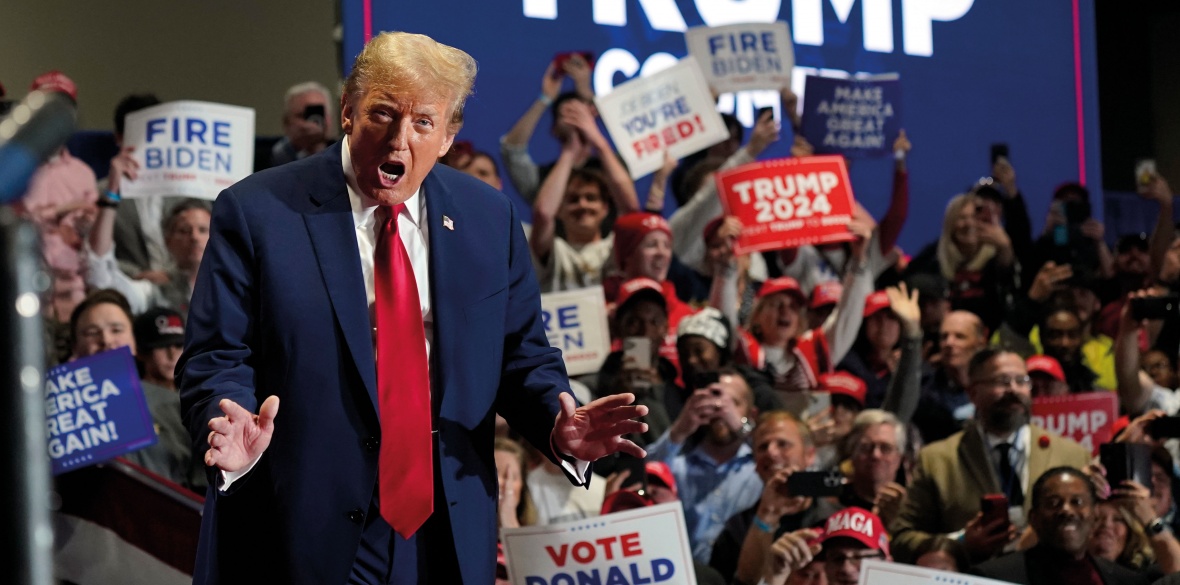This is the last article you can read this month
You can read more article this month
You can read more articles this month
Sorry your limit is up for this month
Reset on:
Please help support the Morning Star by subscribing here
THE US is heading towards a presidential election in November. But regardless of whether Biden or Trump, the two likely candidates, wins, the US will continue to prefer to spend money on warfare rather than welfare.
For more than 80 million US citizens born after 2001 warfare has been a normal state of affairs. They have never known peace.
The US has been at war for 231 of the last 245 years. Beginning with the revolutionary war in 1775, the US has been openly involved in 107 wars since it gained independence.
The US has spent more time at war than any other country.
According to the Office of Management and Budget, the US spent around $800 billion (£634 billion) on its military-industrial complex (in 2022), which amounted to 15 per cent of US federal spending.
Some 40 per cent of the money from the arms industry goes into US coffers.
This money goes somewhere and it is into the pockets of the heads of the biggest arms manufacturers in the history of the world.
Smedley D Butler, a retired US Marine Corps major general, wrote in his 1935 book, War is a Racket, that war is “conducted for the benefit of the very few, at the expense of the very many,” with only a very few making huge fortunes.
Before that devastating collective punishment that Israel is carrying out against the Palestinians because of the attack by Hamas on October 7, and before the Houthi-led Yemeni government attacked shipping in and around the Red Sea, the arms companies were raking in the profits without shame.
Greg Hayes, chairman and CEO of Raytheon Technologies, the US’s largest arms dealer, told shareholders that his company saw the Yemeni attacks against the United Arab Emirates, and counter strikes against Yemen by the Saudi-led coalition as massive “opportunities for international sales.”
During a quarterly earnings call with investors on January 25 2022, Hayes identified current tensions in the Middle East, eastern Europe, and the South China Sea as drivers “putting pressure” on defence spending, with Raytheon well placed to “see some benefit from it.”
Imagine his complete delight about the turn of events in Israel on October 7, 2023.
Gaza, as well as Ukraine, is bonanza time for the arms manufacturers of which all the leading players are US-based.
Raytheon and the other arms dealers make no secret of the donations they make to political candidates and already-elected representatives.
They need to promote war to secure and increase their profits.
Politicians know that they will be paid handsomely for supporting war while they are in office and that they will likely be rewarded by a lucrative seat as a director of one of these death dealers once they leave office — providing they continue to toe the line.
When politicians profit from the sale of arms, then wars become sold to voters as new products.
What the US government calls “corruption” in west Asian countries is the same thing it calls “lobbying” or “pathways to influence” at home.
A 2021 report found that defence contractors spent over $200 billion (around £158 billion) lobbying the US government from 2019 until the report was published.
In the meantime, the official poverty rate in the US is somewhere around 12 per cent, with more than 38 million people in poverty.
The majority of adults living in poverty are not, as they are sometimes portrayed by politicians of both major US parties, unemployed and under-educated. Most of those in poverty in the richest country on the planet are in work and have at least a high school education.
But the US would rather spend its money on using its military power than making sure that its people have enough money to live on and that they stay healthy.
The US federal minimum wage is $7.25 per hour (around £5.72). The official unemployment rate in the country is 3.7 per cent.
This indicates that the US is an essentially low-pay economy where the vast majority of people are struggling to survive at a time when trade unionism is at its lowest ebb.
Union membership rates fell last year to 10.0 per cent from what had already been a record-low 10.1 per cent in 2022.
Struggling to survive also makes you unhealthy. Life expectancy in the US has fallen to 76 years, while children in the US are less likely to reach the age of five.
The US is, by most measures, in a pretty bad way, and I have not even touched on the rampant racism on which the country was founded and which still ruins the lives of so many people today.
While many in the US baulk at the idea of describing the society in Israel as being a form of apartheid they actually have a form of this system of segregation within their own shores.
The fact that segregation exists in the US should be no surprise to anyone with even the most scant knowledge of the 1960s civil rights movement.
But the idea that segregation is still deeply ingrained into the US system might be less well understood.
Even with legislation such as the Fair Housing Act of 1968, the segregation of African-Americans and Latinos, in particular, into sub-standard housing in under-resourced neighbourhoods that are also food deserts with little local access to quality food, persists.
In some urban areas, the degree of African-American segregation is so intense and occurs in so many dimensions simultaneously that it amounts to “hyper segregation,” or a form of apartheid.
The US system of extreme segregation has created urban areas of significant poverty that politicians from the mainstream parties have shown little inclination to tackle in any meaningful way.
There is absolutely no indication that whoever wins the presidential election in November will prioritise tackling the deep-seated problems in the US.
Whether Biden or Trump is eventually triumphant and styles themselves as the “leader of the free world,” it is certain that they will continue to provide the bottomless pit of money to feed the ever-hungry military-industrial complex.
It must be obvious that placing trust in either of the two major political parties means just more of the same warfare over welfare.
If the height of ambition of US voters is who is less worse then that’s really no ambition at all — and certainly nothing for the vast majority of US citizens to look forward to.









